Delairea aparadensis
Delairea aparadensis is a new species in the Delairea genus native to Brazil, where it was described in 2021. Critically endangered using the IUCN criteria, it is the second species in the Delairea genus, with the first one being D. odorata (a South African native).[2][3]
| Delairea aparadensis | |
|---|---|
 | |
| In natural habit | |
| Scientific classification | |
| Kingdom: | Plantae |
| Clade: | Tracheophytes |
| Clade: | Angiosperms |
| Clade: | Eudicots |
| Clade: | Asterids |
| Order: | Asterales |
| Family: | Asteraceae |
| Subfamily: | Asteroideae |
| Tribe: | Senecioneae |
| Genus: | Delairea |
| Species: | D. aparadensis |
| Binomial name | |
| Delairea aparadensis Funez & Hassemer[1] | |
Discovery
A field work took place in southern Brazil from 2008 to 2020, where, in the latter year, a group of a scandent species of Senecioneae were discovered. The species looked morphologically distinct from the Brazilian native members of the Senecioneae tribe that are present in South America and were more comparable to those in Southern Africa.[2]
The 2021 report confirmed that the rambling species matched an undescribed species of Delairea (previously a monospecific genus), due the climbing habit, discoid flowers and the leaves' succulent nature.[2]
Description
A rambling subshrub and a perennial herb growing around 40 cm to 150 cm tall, it features erect, glabrous, foliose, green stems with toothed, veined leaves which decrease in size towards the apex, and yellow discoid flowers. D. aparadensis is distinguished from D. odorata by its deltoid leaves, being a rambling subshrub (whereas D. odorata is a vine) and its inflorescences made up by cymes of 2–6 capitula (as opposed to dozens of capitula in D. odorata). Flowers appear in March in the region, or early autumn.[2]
Distribution
The species is found in Southern Brazil in regions such as, Aparados da Serra National Park, Morro da Igreja, in São Joaquim National Park, and at Urubici in Santa Catarina, where it is present in cloud forest environment, at elevations of 1700–1800 m. Critically endangered, it is found roughly in area of occupancy of less than 1 km2 due to the agricultural spread in Santa Catarina.[2]
References
- "Delairea aparadensis Funez & Hassemer". International Plant Names Index (IPNI). Royal Botanic Gardens, Kew; Harvard University Herbaria & Libraries; Australian National Botanic Gardens. Retrieved 2023-07-24.
- Funez, Luis A.; Hassemer, Gustavo; Peroni, Nivaldo & Drechsler-santos, Elisandro R. (2021). "Delairea aparadensis (Asteraceae, Senecioneae), the first native species of the genus in the Americas". Phytotaxa. 494 (1): 122–128. doi:10.11646/phytotaxa.494.1.8.
- "Delairea Lem". kew.org. Royal Botanic Gardens, Kew. Retrieved June 12, 2023.